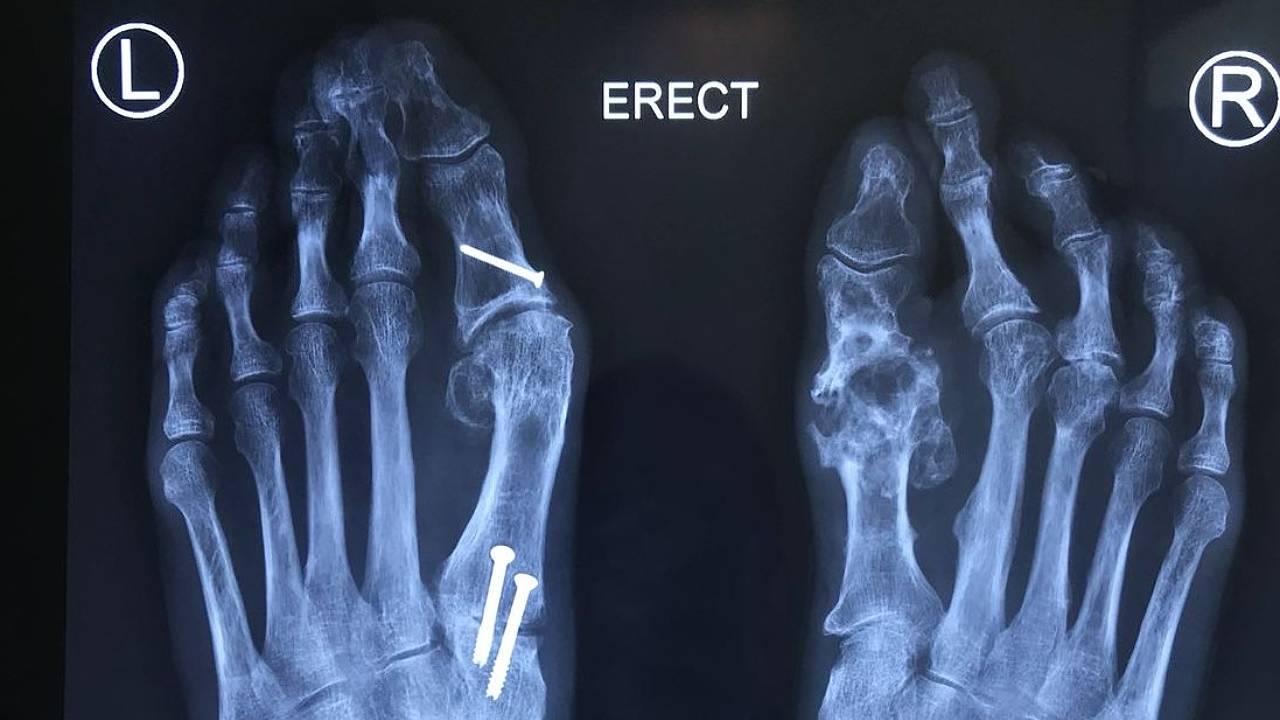Gout is a relatively common joint inflammation that occurs in a short period of time. Many patients assume the pain is due to bone, muscle or tendon injury, especially if it is the first time they are experiencing an acute gout attack. These attacks result in inflammation and extreme pain.
We see three types of gout patients at East Coast Podiatry:
- First time occurrence of a gout flare-up
- Occasional flare-ups with some long term effects on their joints setting in
- Advanced stages of gout with tophi and gouty erosions present within and around the joints
If gout is left unaddressed, the attacks will become more frequent and severe over time. The buildup of uric acid crystals between attacks is known as intercritical gout. Gout can affect any joint in the body, but it most commonly affects the big toe. Over 90% of gout cases involve the big toe joint. Long term complications of gout include kidney failure and gout induced osteoarthritis.
What causes gout?
Gout is caused by having too much uric acid in the bloodstream, which is also known as hyperuricemia. This means that the primary cause for gout in most patients is their diet and/or lifestyle.
The average Singaporean diet is protein-heavy, which increases the likelihood of a gout attack as the body produces more uric acid while breaking down these purine-containing foods. Those who regularly consume foods, such as organ meats, venison, sausages, bacon, seafood, and shellfish, face even greater risk due to the very high concentration of purines.
Alcohol consumption also affects uric acid levels in the body by slowing down the excretion of uric acid from the kidneys due to dehydration. Instead, the crystals are deposited in the joints.
Risk factors for gout include:
- Obesity, excessive weight gain especially in youth
- Moderate to heavy alcohol intake
- High blood pressure, High cholesterol and Ischaemic Heart Disease
- Diabetes and Abnormal kidney function including renal failure
- Certain medication, such as diuretics
- Certain diseases, such as Lesch-Nyhan syndrome
Some studies have also shown that patients with abnormally low or high thyroid hormone levels may develop gout due to complications associated with kidney function.
What is a gout attack?
Acute gout attacks are characterized by a rapid onset of pain in the affected joint. Acute attacks may be precipitated by sudden fluctuations in uric acid levels brought on by a spike in alcohol consumption, stress, starvation, rapid weight loss, and the introduction of uric acid-lowering drugs.
Symptoms of a gout attack can include:
- Inflammation
- Painful swelling
- Reddish discolouration
The symptoms usually reach maximum intensity within 8-12 hours of presentation and can reach excruciating levels of pain that disable the patient. The big toe joint is the most common site for an attack. Other joints that can be affected, include the midfoot, ankles, knees, wrists, fingers, and elbows.
In some people, the acute pain is so intense that even a bed sheet touching the toe causes severe pain. In some instances, an attack may not subside entirely, especially if the patient’s uric acid levels are consistently high.

What are the long-term effects of leaving gout uncontrolled?
Gout is a progressive disease; Leaving gout attacks to subside or recover on its own allows uric acid crystals to accumulate within a joint, leading only to further attacks in the future. Over time the secondary effects of gout come into play, with patients often developing severe bone erosions from the chronic uric acid build-up and crystal deposition into the joints. As the feet can take up to 300% of a person’s body weight daily, joint erosions can quickly advance into secondary, painful arthritis.
If joint damage has already taken place, medication alone is insufficient to address the cause of pain or resolve the underlying joint problems. There may be knock-on effects of a joint compromised by gout causing secondary musculoskeletal pains in other areas of the foot and ankle, or knee.
Ultimately, a failure to properly handle uric acid in the body will result in more than joint damage. Long-term crystallisation of these compounds can cause attacks of kidney stones and uric acid crystals build-up in the kidney filtering tubules, leading to kidney failure.
What should you do if you suspect you have gout?
Gout management in Singapore can be divided into several phases. The first phase is to deal with pain and inflammation. This can be done by staying hydrated, resting, and using an ice pack to relieve the inflammation until a foot specialist or a podiatrist is able to assess the affected area.
To confirm the diagnosis, patients will undergo clinical evaluation and a thorough history taking to determine if gout is the true cause of their pain and foot/ankle problem. This can include utilising clinical imaging, such as diagnostic ultrasound or x-rays to give a clear visualisation of the underlying problem.
Oral medications should be continued to help to manage the systemic cause of gout, aiming to prevent further attacks and complications, such as gouty arthritis, kidney stones, and tophi in the soft tissues. However, it will not address the joint or bone damage already caused by gout.
A podiatrist will use various non-invasive clinical modalities/ therapies to reduce the immediate pain and inflammation of gout attacks. Once the immediate effects of the attack have been reduced, podiatrists can address the resulting joint pain and deformity by adjusting the foot and lower limb biomechanics by using customised in-shoe devices for joint stabilisation and utilizing advanced technologies for improving joint quality and mobility, while enhancing pain-free lower limb function while minimizing long-term joint damage.




